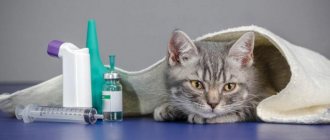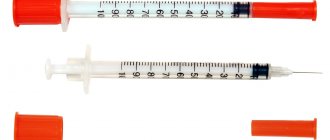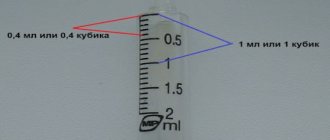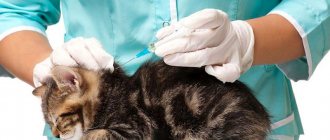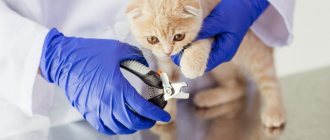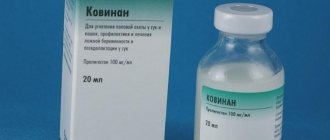07/04/2018 Intramuscular injection is a simple and popular method of introducing medications into the human body. However, if this procedure is carried out carelessly, complications may arise, which can be avoided if you master the correct technique for performing it.
Knowledge of the intramuscular injection procedure algorithm is needed not only by doctors. In the life of every person, a situation may arise when it is necessary to undergo a course of injections on your own. Before practicing intramuscular injections in practice, you need to carefully study the theory regarding this manipulation. Compliance with all standards will avoid complications.
In what places can the injection be given?
For both people and animals, injections are placed under the skin, into a vein, muscle, joint, or intra-abdominal space. Intravenous, intra-articular, intra-abdominal injections can only be done by a specialist (in extreme circumstances, you can see how this is done in a clinic, ask about the features of the technique and try it yourself under the supervision of a doctor). And any owner can master the technique of injecting medication intramuscularly and subcutaneously. The cat should be given an injection only in areas whose anatomical features make it possible to achieve the greatest therapeutic effect. For intramuscular injections: the back of the shoulder and thigh muscles, subcutaneous - the fold between the shoulder blades at the withers, the fold between the torso and the front of the thigh. Which method to choose and where to administer the medicine depends on the chosen drug.
How to choose the right syringe
The syringe is also selected depending on the drug - its volume and injection site. For injection into the muscle, instruments with a volume of 1-10 ml are suitable. If the amount of medicine is large enough, for smooth administration you should purchase a syringe with a piston equipped with a special seal. For a small volume of injection solution (up to 1 ml), an insulin syringe with convenient graduation is used.
It is advisable that the needle used to administer the drug intramuscularly is not too long. The femoral and brachial muscles of cats (especially kittens) are small, which increases the risk of damage to the sciatic nerve or bone. An insulin syringe equipped with a thin and short needle will also help out here. An injection into muscle tissue is more painful than under the skin, and a thin, sharp needle will slightly reduce pain.
Subcutaneous injections are tolerated more easily by animals - there are not too many nerve receptors in the withers. Needles can be longer and thicker, and syringes of different sizes, depending on the indications. Typically, the amount of medication injected into the subcutaneous space is greater than into the muscle.
When selecting an instrument for giving injections to a cat, take into account the consistency of the drug. Oil solutions are distinguished by viscosity, ductility and require larger diameter needles.
Lameness
Limping on the hind leg is common after injection. Most often, this happens after painful injections - antibiotics or thick, oily medications.
Veterinarians assure that there is no need to worry about lameness - most often, pets begin to run on the 2nd day.
But if your Murzik has been limping for 3-4 days, then you need to take action, since this is not a normal phenomenon. In this case, you need to show the cat to the doctor as soon as possible, and he will determine the cause of the lameness and prescribe the appropriate course of treatment.
Choosing a syringe for injection
Instruments for pets are purchased at a regular pharmacy for people. There are three types of injections: intramuscular, subcutaneous, intravenous. Each option requires different syringes and needles.
For intramuscular
In this case, the injection is carried out into the muscle of the cat's back or front leg. Syringe volumes are allowed: 1, 2, 5, 10 ml. If you need to administer a dose of more than 1 ml, you need to choose three-component syringes. In addition to the needle and piston, the design includes a plunger that allows the needle to move gently. The black seal is located at the end of the piston where the needle is inserted.
After choosing the correct volume, you should decide on the needle. For a cat and especially a kitten, it is better to choose thin needles. When choosing a syringe with a capacity of 2.5 ml or more, take a 30x0.6 mm needle or from an “insulin syringe”.
“Insulin syringes” work well with doses less than 1 ml. They got their name from the frequent administration of insulin to diabetic patients. The tool has two positive characteristics. First, it has a plunger for gentle movement. Secondly, the needle is short. Beginners should not worry about the depth of the needle.
Important! The needle must be very sharp. If she was getting medicine through the rubber stopper, the needle should be replaced.
For subcutaneous
In this case, the injection is made into the withers of the animal. Since the skin here is soft, not so stretched, it has few nerve endings. The cat feels less and, therefore, tolerates even painful injections well.
The volume of the syringe can be different, but the needle should be chosen 30x0.6 ml. This is the case if the medicine is not oil-based.
Often subcutaneous injections are accompanied by medications with an oily structure. To prevent the drug from clogging the passages in the needle, you need to choose needles of a larger diameter, since the oily and viscous structure of the drug hardens quickly. For example, if the syringe has a volume of 3 ml, then the needle should be selected 40x0.7 mm, etc.
Intravenous injection is carried out only by specialists.
Nutrition for lung recovery after COVID-19
It is recommended to eat nutritious meals 5-6 times a day, in small portions.
Table 2. Required nutritional components
| № | Component | Product examples |
| 1. | Easily digestible protein | Chicken, turkey, young beef, cottage cheese, eggs. |
| 2. | Healthy fats | Sea fish, nuts, vegetable oils. |
| 3. | Alimentary fiber | Cereals, fresh vegetables and fruits. |
| 4. | Slow carbohydrates | Cereals, vegetables. |
| 5. | Probiotics | Fermented milk drinks, sauerkraut. |
| 6. | Iron | Parsley, beef liver, buckwheat. |
You need to drink 1.5–2 liters of water per day. Regular drinking water, fruit drinks, unsweetened compotes, and rosehip decoction are suitable.
Prohibited: “fast” carbohydrates - cakes, sweets, buns, fatty, hot, spicy foods, deli meats.
Preparing for the injection
Before you give your cat an injection, you need to prepare everything you need.
- Determine the location where the procedure will be performed. It should be smooth, not slippery, preferably at the level of a regular table.
- Before taking the medicine, you should make sure that the drug is not expired. It will not be superfluous to re-read the instructions for the medicine, as well as the veterinarian’s prescription for time and dosage.
- The cold preparation must be warmed up to body temperature (it is enough to hold it in your hand for a while).
- To draw the medicine from the ampoule, its upper narrow part is broken, first wrapped with a piece of cotton wool.
- The powder form of the product must be diluted with saline, novocaine or a special solution included in the kit (check with your veterinarian for details on dosage). First, the solution is drawn into the syringe, then it is injected into a vial of powder, the medicine is dissolved with light circular movements (without shaking), and then drawn back into the syringe. After this, it is advisable to change the needle.
- When the medicine is drawn up, you should get rid of air bubbles - lift the syringe with the needle up, lightly tap the cylinder, ensuring that the bubbles accumulate under the medicine outlet, press slightly on the piston until the air comes out and drops of the drug appear.
Unneeded cotton wool, ampoules and other items should be disposed of, and the prepared syringe can be briefly placed on a clean surface (plate, container), covering the needle with a cap.
Exercise to treat lungs after COVID-19
Exercise therapy strengthens muscles weakened by disease, stimulates blood circulation, and normalizes the nervous system. Gymnastics are performed after breathing training, at a slow pace. You need to place a chair nearby and hold the back of it with your hand to control your balance. The first part of each exercise is performed while inhaling, the second – while exhaling.
Sample list of exercises
- Rise on your toes, stand on your full foot.
- Bend your leg at the knee, lifting it up and lowering it. Then - the second leg.
- Take your leg back and return it to its place. Same with the second leg.
- Circular movements of the shoulders forward, then back.
- Take your right hand back, return to the starting position, then your left.
- Place your hands on your belt. Turn your torso to the right, then to the left.
- Lean forward 20–30 degrees, straighten up.
- Bend to the right, straighten up, then to the left.
Possible difficulties
For a non-specialist, giving an intramuscular injection can be difficult, especially for the first time. It must be remembered that anxiety is transmitted to the pet, so it is very important to remain calm. The injection is necessary in order to help the animal, so there is absolutely no need to feel guilty.
If after an intramuscular injection blood appears on the surface of the skin or fur, this is considered normal. But if the bleeding does not stop, then you need to apply something cool to the manipulation site for 15-20 minutes. It is important not to overdo it and not to overcool the injection site.
Lameness may persist for some time from the injection of painful drugs, but if the limb hangs lifelessly and has lost mobility, this is a reason to seek advice from a specialist.
Publications by doctors from the Family Doctor clinic on the topic “How to overcome post-Covid syndrome”
- Restoring the sense of smell after coronavirus
- Restoring memory after suffering from coronavirus
- Overcoming mental disorders during post-Covid syndrome
- Loss of smell due to COVID-19 - advice from an otolaryngologist
- Post-Covid screening - examination after a new coronavirus infection
- How to return digestion to normal after coronavirus?
- Recommendations from a cardiologist after suffering from COVID-19
- Coronavirus turned out to be “vindictive” - what is important to know
- We are experiencing COVID. How the coronavirus pandemic affects mental functioning
- Melatonin and COVID-19 - a cure for Trump
- Post-Covid syndrome: program for diagnosis and regression of post-Covid symptoms. How to Manage Long-Term Long COVID Symptoms
How to give an injection in the thigh
An intramuscular injection into a cat is given into the thickness of the femoral or brachial muscle. Before making an injection, it is necessary to palpate the muscle, determine the injection site, and make sure that the animal is calm and the muscle tissue is relaxed. For relaxation, you can pre-massage the limb.
The angle of insertion of the needle into the thigh should be approximately 90˚, the penetration depth should be no more than a centimeter. It is necessary to ensure that the needle does not completely enter the muscle - there should be a gap between the surface of the body and the plastic.
As soon as the needle is in the muscle tissue, you need to calmly press the plunger and slowly inject the medicine. You cannot move, turn, or deepen the syringe while giving an injection. Remove it in the opposite direction, with a quick movement.
General recommendations for lung rehabilitation after COVID-19
- Maintaining a daily routine, getting a full eight hours of sleep
- Moderate physical activity (10,000 steps per day - walks in the park, forest in dry and warm weather). On a cold, windy or rainy day, it is better to stay home. For a walk, dress according to the weather; shoes should be comfortable.
- Breathing exercises
- Daily wet cleaning and ventilation of the room.
- Refusal to visit the bathhouse or sauna. You should not take hot baths.
- Prohibition on drinking alcohol and smoking.
Where to give an injection to a cat
Despite the fact that, in theory, you can hit it almost anywhere, there are places on the animal’s body where it will be more effective and less painful. The cat can be injected subcutaneously into the withers (between the shoulder blades) or intramuscularly into the thigh. The muscle tissue of the thigh has a large number of vessels, so any injected medicine is very quickly delivered to the blood. An injection is given into the thigh if the drug is not very painful. In some cases, intramuscular administration is preferable, so you should carefully read the instructions. Intramuscular injections are limited in volume - liquid injected inside causes greater muscle separation, which is a microtrauma.
The skin on the withers is denser, so it is better to address “painful” solutions to this particular place - just remember how animals fight and grab each other precisely by it.
General rules
Often, the veterinarian prescribes a course of parenteral injections for the cat, which are placed subcutaneously (in the withers area), in the thigh muscle or shoulder. In order to inject a cat correctly and without consequences (in the withers area or muscle), it is important to know a few rules:
- Only a warm solution can be administered (this is especially true for vaccines and drugs that are stored in the refrigerator). The medicine should be at approximately room temperature. This can be achieved if you take out the bottle in advance (2-3 hours before the procedure) or warm it in warm water. If this rule is neglected and a cold solution is introduced, there is a high probability of the formation of difficult-to-absorbable infiltrates.
- It is necessary to prepare several spare syringes. Often you have to draw liquid from a bottle with an aluminum cap, and this leads to the formation of nicks on the needle, which causes additional pain for the cat when administering the medicine. If the solution was pre-mixed, viscous or poorly dissolved, the needle cavity becomes clogged. In such cases, it is recommended to draw the drug into the syringe with one needle, then replace it with a new one.
- Always expel the air from the syringe cavity before injecting. Otherwise, there is a risk of a bump or bruise. This offense will not bring a mortal threat, but will complicate further injections.
To remove air bubbles, use a finger on the body of the syringe or rotating movements to collect all the small bubbles into one large one and then remove it.
Syringes are different and sometimes it is extremely difficult to remove all the bubbles. In this case, when injecting the solution, it is necessary to hold the syringe piston vertically upward (the medicine will leave, but the air will remain in the syringe).
- Carefully read the instructions for the prescribed drugs, especially if you need to combine several components (for example, when vaccinating or creating complex solutions). In such processes, mixing sequence is important for optimal dissolution.
If the doctor prescribed several injections in one period of time, then it is worth checking about the possibility of combining solutions together. If this is contraindicated, then it is necessary to inject with a short time interval.
- Change injection sites if you have to do them frequently. Subcutaneous injections can be given to the cat at the withers (scruff), in the area of the shoulder blades or groin. The withers are the highest point of the body and are located on the spine between the cat's shoulder blades. Moreover, the skin on the withers is much thicker and more difficult to pierce with an insulin syringe than that above the shoulder blades.
Intramuscular injections are given to cats in both the hind (pelvic) and fore (thoracic) limbs.
- Determine on your own the method of administering the medication, based on the volume or dose (this only applies to those medications that can be administered by any parenteral route, bypassing the gastrointestinal tract). Large volumes of medications (over 3-5 ml) are good to inject into the cat’s withers (the skin stretches well and the likelihood of bumps forming is reduced). Solutions in a volume of up to 3 ml can be safely injected into the paw, and their effect will appear a little faster.
For example, the doctor prescribed 3 ml injections to the cat in the withers area or muscle (the injection point is at the discretion of the owner). Injecting the drug subcutaneously will be less painful for the pet.
Important to remember! Air bubbles occupy a certain volume, which leads to an error in dosing the product. This should be taken into account when administering small doses of potent medications.
Choosing the right syringe and needle
When choosing a syringe, two factors are important: the size of the cat (weight, age) and the consistency of the injected drug. The larger and thicker the pet, the longer the needle should be. Accordingly, 2-10 ml syringes are suitable for adult and well-fed cats.
Smaller syringes (1 ml) can be used to inject cats intramuscularly into the thigh, but the medicine should not be thick.
For kittens and malnourished animals, 1 and 2 ml syringes are optimal.
Important! It is not recommended to place a needle from a larger syringe on an insulin syringe, or vice versa (the needle may fly off while pressing the piston).
Changing the needle to a thinner one is allowed in cases where the cat is indicated for subcutaneous injection of 10-20 ml of liquid or more. For this manipulation, it is better to draw the medicine into a large syringe and then change the needle.
Important! The cat should be given an injection with a disposable and sterile syringe. Do not use the same instrument twice to avoid clogging the needle and mixing different drugs.
Do I need to treat my skin with an antiseptic?
Antiseptic treatment of the injection site in cats with fur is useless. Manipulation makes sense only for hairless cat breeds (Sphynx, Elf, Bambino, Cojona, Peterbald, Ukrainian Levkoy).
Needle insertion depth
The most important thing in the process of giving an injection to a cat is to deliver the medicine strictly according to indications. When injected into the withers area - under the skin, and when injected intramuscularly - into the muscle. Therefore, a novice “doctor” should practice on a chicken carcass.
The injection into the cat's withers is made no deeper than 1-1.5 cm. If you overdo it, you can pierce the skin fold completely, which will be visually noticeable by the trickle of medicine flowing out or the fur around it getting wet. The angle of needle insertion when injecting under the skin should be 45 degrees.
The depth of intramuscular injection is determined taking into account the size of the animal’s paw and the length of the needle. Approximately the needle is inserted half or 2/3. You should not insert the needle completely, it may break and go into the thickness of the muscle fibers. The correct angle of the syringe is 90 degrees to the surface of the skin.
Attention! The manipulation must be carried out confidently and quickly, as the cat experiences pain. She will loudly express dissatisfaction and try to escape by any means. Therefore, veterinarians advise that before injections, be sure to trim the claws and securely restrain even a very calm cat.
Speed of drug administration
Descriptions of medications sometimes indicate the rate of administration (especially if the drug is viscous or viscous).
Correct fixation
To securely hold a cat, the following are suitable:
- a fixing bag is an excellent and useful invention for obstinate animals, it allows for various manipulations (injections in the withers and legs, trimming claws, examining the mouth) and will protect a person from the sharp claws and teeth of a cat;
- a thick blanket or towel in which to swaddle the cat;
- a strong assistant who needs to grab the animal’s front paws with one hand and the hind paws with the other.
If the pet is calm or in a depressed state, then it will be quite enough to place the cat on four paws on the floor or table, ask an assistant to hold it by the withers and hind leg until the procedure is completed.
How to give a subcutaneous injection
It is easier to inject a cat under the skin than in the thigh. Firstly, the withers are considered less sensitive to mechanical influences (it’s not for nothing that cats drag their cubs by the withers), so this place is ideal for administering painful solutions. Secondly, much larger volumes of medicinal solutions (up to 70-90 ml) can be injected subcutaneously than into the femoral part. Thirdly, there is no risk of the needle getting into a bone, joint or nerve, as happens with intramuscular injection. The only point that needs to be paid special attention to is that the skin here is thicker than the thigh, so you need to apply force to pierce it.
The injection technique under the skin is as follows:
- With one hand, the skin in the withers area needs to be gathered into a fold;
- with the other hand, under the skin pulled upward closer to the body, with some effort, insert the needle at an angle of 45˚ relative to the surface of the body;
- administer a medicinal product;
- remove the syringe;
- release the skin.
It is advisable that someone from the side during the procedure slightly press down the head and back of the pet’s spine.
Important! If you have no experience in administering medication subcutaneously to your cat, there is a risk of piercing the skin through. This probability is due precisely to the thickness of the skin and its resistance during piercing with a needle. Therefore, during the injection process, you need to pay attention to the opposite side of the fold - if droplets appear on it, you need to pull the needle a little towards yourself, and then continue the procedure.
Breathing exercises for lung recovery after COVID-19
Breathing exercises stimulate blood circulation, train the respiratory muscles, increase the elasticity of the lung tissue, and improve bronchial drainage. You need to perform gymnastics in a clean, ventilated room. Start with 30 seconds, gradually increase to a quarter of an hour. Overwork should be avoided. If you feel dizzy, take a break.
Preparatory exercises
- While lying on your back, inhale slowly for 3–4 seconds, then exhale the same slowly for 5–6 seconds.
- Diaphragmatic breathing, when the stomach “inflates” as you inhale.
- Slowly inhale air, slowly exhale through a straw into a glass of water, and relax. Repeat 2-3 times, gradually increase to 10 times.
Initial exercises
- Sit on a chair, press your back against the back of the chair, lower your arms down. As you inhale, gently raise your arms forward and then up. As you exhale, return to the starting position.
- The same exercise, only raise your arms up to the sides.
- Stand up, put your fingers on your shoulders. As you inhale, slowly spread your arms to the sides. Exhaling through your mouth, return to the starting position.
Basic exercises
Gymnastics by A. N. Strelnikova has proven itself well. It is difficult to master it on your own. It is necessary that the movements be shown by a person who knows the technique. Instead of this breathing exercise, your doctor may recommend another one.
Administration technique
The speed of drug administration plays a role with intramuscular injection. The more medicine, the slower it must be administered. For example, a volume of 1 ml should be stretched over 2-3 seconds, and 0.5 ml should be injected in one second.
Injections separate the muscles and thereby cause microtrauma to the body. Therefore, a certain calculation is used to administer the required amount of medicine for cats of different weights. For an average cat weighing 4 kg, one place should contain 1 ml of the drug. If you need to inject a larger amount, then you need to inject in several places.
With a subcutaneous injection, the speed of drug administration is not significant. The amount of liquid per 1 kg is limited to 70 ml.
Intramuscular injection
In order for the medicine to work quickly, an intramuscular injection is usually given. The best place for injection is considered to be the middle of the thigh.
Algorithm of actions
Preparation:
- The procedure will be quick and successful if you carry out the preparatory work. We put cotton wool, a syringe, medicine, a file, and alcohol on the table in advance.
- Read the instructions carefully. Let's say you notice a discrepancy with your veterinarian's prescription. Call your doctor and find out before you get the injection.
- Wash your hands with soap and wipe with alcohol.
- Before filing the ampoule, make sure the medicine is at the bottom. If the medicine gets into the narrow part of the bottle, tap the sides with your finger and distribute it correctly.
- Point the needle into the cut neck and turn the ampoule over. This will make it more convenient to collect liquid.
- Once the solution is drawn into the syringe, turn the syringe upside down with the needle so that the air droplets rise up. Press the plunger until the needle is filled with medicine and the air is expelled.
- Don't worry before the procedure, otherwise your cat will sense it and become agitated and tense. You need to calm the cat with caressing movements to relax the muscles.
- There is no need to lubricate the injection site with anything, as this can only damage the antibacterial layer of the skin.
Injection:
- If you have a partner, let him put the cat on its side and hold it by the paws. For independent actions, you can use a bag with a fixative for injections. Also use a large clothespin. Fasten it behind the withers. The cat will think that someone is holding it and will sit quietly. The owner has the opportunity to work with both hands.
- Use your fingers to feel the bone in advance so as not to hit it with a needle.
- There is no need to pinch the injection site in the muscle.
- Some medications should not enter the blood vessels. Therefore, during the injection, pull back the plunger and make sure that no blood enters the syringe and calmly inject the solution. If there is blood, remove the needle and make a new puncture.
- Insert the needle into the middle of the thigh 10 mm at an angle of 45 degrees.
- The rate of administration depends on the amount of solution. Each ml of medicine must be administered for at least 2-3 seconds, each subsequent ml is administered more slowly.
- After injecting the liquid, pull out the needle at the same angle that was inserted before. There is no need to wipe the injection site.
Physiotherapy after coronavirus
Table 3. Popular physiotherapeutic procedures
| № | Name | Action |
| 1. | SMT therapy | Sinusoidal modulated currents eliminate bronchospasms and improve drainage. |
| 2. | Laser therapy | Improves blood circulation, has a resolving and anti-inflammatory effect. |
| 3. | Polychromatic polarized light | Accelerates the resorption of infiltrate, improves bronchial patency. |
| 4. | Magnetotherapy | Eliminates inflammation, swelling, pain. |
| 5. | Ultrasound therapy | Removes phlegm, prevents the development of fibrosis. |
What complications may there be?
The introduction of medicinal solutions, regardless of the location, injures the surrounding tissues. Complications can arise not only when the procedure is carried out ineptly, but also from an experienced specialist. The most common negative consequences of injections are:
- hematomas – formed due to damage to a blood vessel by a needle and penetration of blood into neighboring tissues; they do not require special treatment and go away on their own;
- blood protruding after removing the needle - just as in the previous case, serves as a sign of damage to the blood vessel; to stop the bleeding, it is enough to apply cold to the wound;
- bump, compaction, swelling at the injection site - can have several reasons, for example: too rapid administration of the medicine, infection entering the wound, individual tissue reaction, and others; if the bump does not go away for a long time, and the cat’s well-being worsens, you need to show your pet to a specialist;
- lameness - can be a consequence of the injection itself, as damage to soft tissues, for example, with severe pain from the solution, or as a result of the needle getting into the sciatic nerve; in the latter case (if the damage persists for longer than 2-3 days and the paw remains motionless), you need to visit a veterinarian;
- deviations in behavior are a normal reaction of an animal that goes away on its own over time; the cat may panic, avoid touching, flinch, and so on;
- an increase in body temperature - more often occurs as a reaction to the injected solution, a manifestation of an allergy, and also if sterility was not maintained during the procedure and an infection got into the wound.
Additional symptoms that you need to pay attention to and consult a doctor: pus from the skin puncture site, painful lumps, refusal to eat, loss of activity, apathy for more than 3 days after the injection.
Principles of pulmonary rehabilitation after COVID-19
Rehabilitation begins 20–25 days after the onset of the disease, sometimes while still in the hospital. As soon as the acute process is over, the body temperature has returned to normal, an examination is carried out. It is clarified whether there is dysfunction of the kidneys, heart, blood vessels, or other organs. The lung recovery program after COVID-19 is developed individually. Taken into account:
- the severity of the coronavirus infection;
- the nature of viral pneumonia, the degree of lung damage;
- floor;
- weight;
- age;
- associated diseases.
The duration of rehabilitation is from 2 weeks to a year. It can go continuously or in courses of 10–14 days with breaks of 5–7 days. With minimal changes, breathing exercises, physical therapy, inhalations, massage, and physiotherapy are prescribed. Regime and nutrition play an important role.
Possible consequences
Sometimes the procedure does not go without consequences. Therefore, you need to be prepared for them in order to make the cat’s fate easier. Let's look at the most common ones.
Blood at the injection site
Sometimes after an injection you notice a drop of blood. A blood vessel may be damaged. If there is little blood, then you need to take ice, wrap it in a towel and apply it to the wound. After 10-20 minutes everything will pass. If the wound bleeds after applying cold, contact your veterinarian immediately.
Formation of lumps and swellings
Post-injection abscesses are the result of an unsuccessful injection. A bacterial infection enters the wound. The second reason is hypothermia of the pet in the injection area. Consequences: increased temperature, fever, restlessness. The cat develops painful, purulent capsules that are removed by surgery.
Usually, swelling and bumps after injections do not affect the pet’s health. Over time, they will resolve on their own without the intervention of a veterinarian.
Lameness
Lameness of the hind limb often appears after injections. According to veterinarians, there is no need to worry about this. The lameness will go away in a few days.
But if a cat drags its leg for several weeks, you need to contact professional veterinarians to prevent the disease at an early stage. Doctors will carry out a series of novocaine blockades.
Changing your cat's behavior
The pet changes a lot after the injections: nervous, does not allow itself to be petted. Experts explain this as a psychological attack. Cats are afraid of people in white coats and injections. To bring it to its original state, you need to give your pet time. Over time, he will forget everything and will be active and affectionate as before. You can speed up the process with your favorite food; pamper your cat with goodies, and she will respond to your care immediately.
Temperature increase
When the temperature has increased as a result of vaccination, the reaction is considered normal. After 2-3 days all symptoms will disappear. If the temperature continues to persist after 3 days, you should contact your veterinarian. Complications associated with allergies and paralysis may appear here. Based on the identified complications, treatment is prescribed.
A rarer case of fever is associated with an abscess after injections. You should contact your veterinarian to remove the purulent lump.
It is more economical to treat pets at home. But before you make a choice, you should think about whether you are ready to be fully responsible for your actions. Sometimes the right decision may be to trust the professionals. Share with us and readers in the comments practical tips on how you inject your cat.
When a veterinarian prescribes a course of injections for pets, not all owners have the opportunity to bring the animal to the clinic. Also, not every owner has a neighbor or acquaintance (relative) with experience in giving injections. In addition, there are times when a pet urgently needs an injection, but there is no way to contact anyone (at the dacha or on a trip). Therefore, every owner needs to have an idea of how to give an injection to a cat.
The appearance of abscesses
Swelling and ulcers after injection can only appear if you performed this procedure incorrectly. A dangerous microorganism or bacterium penetrates into a small wound, resulting in an infection, accompanied in most cases by tissue inflammation.
The swelling may go away on its own after some time. If this does not happen, then an abscess forms, they are already removed through surgery, after the operation the veterinarian prescribes a course of anti-inflammatory drugs.
Useful tips
To inject your cat yourself and avoid complications, you need to adhere to the following recommendations:
- for injections, you should use only a sterile syringe, which must be disposed of after the procedure;
- the needle must not be touched with hands, otherwise it must be replaced;
- Before carrying out the procedure, it is better to fix the pet in a motionless state, leaving only the injection site of the syringe open (you can use a harness, blanket, sheet and other accessories) or invite someone from the side to hold the cat;
- as a rule, injections are made into an intact area of the skin, so if the animal has any skin disease, you must first clarify this issue with a veterinarian;
- there is no need to disinfect the injection site of the syringe, but the owner must first wash his hands with soap and treat them with an antiseptic;
- if the doctor has prescribed injections every day or several a day, it is best to give injections to the paw alternately - right and left or front and back, in order to avoid severe trauma to the cat’s tissues and allow them to heal;
- oil-based medicine should not be allowed to enter the bloodstream; You can make sure that the needle has not entered a blood vessel by slightly pulling the plunger towards you after inserting the syringe - the absence of blood in the solution indicates that the vessels are not affected, and you can continue the procedure;
- You cannot administer more than one drug at the same time in one syringe, unless authorized by a specialist.
To support a mustachioed pet during the procedure, as well as before and after it, you need to talk to it as gently as possible, stroke it, and calm it down. At the end of the manipulations, you should give the cat something tasty.
Every owner can give a cat an injection on their own, the main thing is desire. It’s good if the skill isn’t useful, but mastering it won’t hurt at all.
When should you contact your healthcare provider?
Call your healthcare provider if you have the following symptoms:
- Blood does not stop flowing from the injection site.
- You have very severe pain.
- You injected the medicine into the wrong place.
- You have a fever of 100.4°F (38°C) or higher.
- You have signs of an allergic reaction, such as swelling, redness, itching, or a rash.
- You cannot use the syringe because the medicine has expired, the medicine has foamed, changed color, become cloudy, or has crystals in it.
- You cannot use the syringe because you touched something with the needle before injecting.
- You cannot use a pre-filled syringe with Lovenox because there is no air bubble in it.
- You are having difficulty administering the injection.
to come back to the beginning
Where to give a cat an injection for cats
Well, you don’t want a kitten at all, and it’s not easy to survive the cat’s heat period? In this case, the issue is resolved by sterilizing the animal. But for some reason, some owners believe that there is nothing easier than suppressing the reproductive instinct, forgetting that the consequences of such a decision can be very dire.
If you definitely want to experiment with your cat and give her a cat injection, then you will still have to visit the veterinarian - this should be the moment before the start of estrus, and not during it. The doctor will administer the medicine himself, and then, after 3 months, the next injection will be given according to the schedule. The third ampoule is administered after 4 months, and all subsequent ones every 5 months.
Why shouldn't you give injections yourself ? This is a big risk even without an inexperienced person, so the entire process must be supervised by a doctor.
Nervous behavior
It happens that after an injection and similar medical procedures, the cat becomes nervous, does not touch itself, and hides from you at every opportunity. In veterinary practice, this phenomenon is called a psychological attack.
This causes changes in the functioning of the nervous system, resulting in fear of injections, stress when visiting a veterinary clinic or even when seeing a person in a medical uniform.
- In this situation, there is nothing you can do, you can only wait.
- After some time, your pet will return to its original state.
- You can try to cope with this with the help of treats, preferably harmless (fish treats, pieces of dehydrated meat, etc.)
Young cats can be entertained with games or walks to distract them from the psychological attack, unless treatment involves reducing activity.
